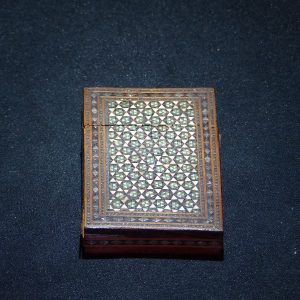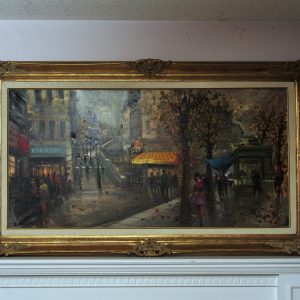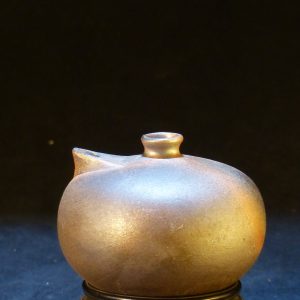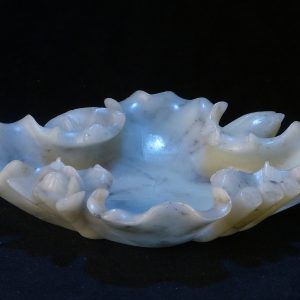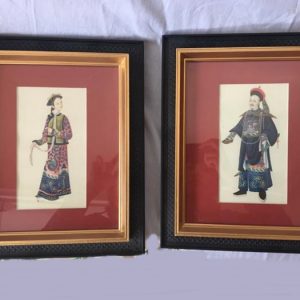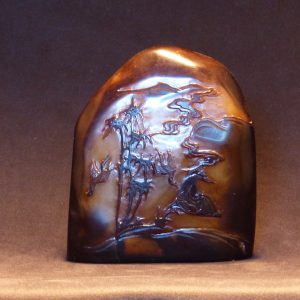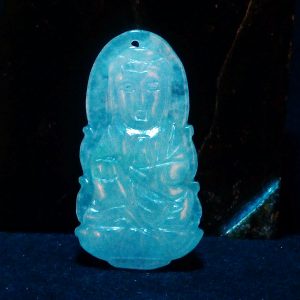Description
清代 满大人男女人物画片
通草纸水彩画
乾隆二十二年,指定广州为唯一对外通商口岸,这里成为中外贸易,文化交流的重要场所。据广州艺术博物院的副院长陈滢介绍,18、19世纪,先后有不少西方画家来到广州作画,令当时的职业画师受到影响。这些掌握了西方绘画技法又熟悉本地风土人情的广州画师,专画符合西方人口味的画销往海外。那些漂洋而来的商人、旅行者、传教士在广州口岸进入中国后,全都要在广州选购画作。西方人觉得它们稀奇有趣,聊作旅游手信,用以展示异域风情。更有商人成批选购运回国出售,成为一条财源。因此,它们就有了一个固定的名字:外销画。
从18世纪中后期开始,在广州珠江北岸专营中西贸易的十三行范围内,出现了一间又一间专售外销画的商铺。1835年的一份资料表明,在广州十三行附近有约三十家商店卖通草纸水彩画,有二三千人受雇制作这些画。通草画,成为当时中国的明信片,记录中国当时的社会民情,自然资源,成为外国人了解东方帝国的方式之一。通草画兴起于1820年左右,到1880年达到巅峰,之后随着照相技术的普及,很快走向衰落,以致绝迹。2000年,英国友人伊凡·威廉斯捐献了一批画给广州博物馆,之后广州博物馆对通草画进行了大量的搜集和研究,慢慢解开了一百多年前这种盛极一时的外销绘画类型。
参考:1799年5月4日由W·米勒在伦敦旧邦德街出版发行的彩色的“满大人”肖像
它极有可能就是英国人梅林编著的著名的《中国服饰》一书的第一幅插图。
为清代外销瓷中“满大人”纹饰正名的新证

1799年5月4日由W·米勒在伦敦旧邦德街出版发行的一幅彩色的“满大人”肖像
在肖像的正下方还有两行手写体的英文:
Pu-qua, Canton,Delin. Dadley,.London.Sculp.
Published May 4,1799 by W.Miller. Old bond Street,London

“满大人”肖像相框背后所附该幅肖像的英文文字说明
这篇英文文字的全文是:
P l a t e I..
Represents
A MANDARIN OF DISTINCTION. IN HIS HABIT OF CEREMONY.
THE dress of a Chinese is suited to the gravity of his demeanor. It consists,in general, of a long vest extending to the ankle : the sleeves are wide at the shoulder,are gradually narrower at the wrist, And are rounded off in the form of a horse-shoe,covering the whole hand when it is not lifted up. No man of rank is allowed to appear in public without boots, which have no heels,and are made of satin, silk,or calico. In full dress he wears a long silk gown,generally of a blue colour and heavily embroidered ; over this is placed a sur-coat of silk,which reaches to the hand,and descends below the knee. From his neck is suspended a string of costly coral beads. His cap is edged with satin, velvet,or fur,and on the crown is a red ball with a peacock’s feather hanging form it: these are badges of distinction conferred by the emperor. The embroidered bird upon the breast is worn only by mandarins high in civil rank,while the military mandarins are distinguished by an embroidered dragon..All colours are not suffered to be worn indiscriminately.The emperor and the princes of the blood only,are allowed to wear yellow:although violet colour is sometimes chosen by mandarins of rank on days of ceremony.The common people seldom wear any other than blue or black,and white is universally adopted for mourning,—The Chinese carefully avoid every word or gesture which may betray either anger or any violent emotion of the mind. They entertain the highest reverence for their parents,and respect for the aged.They are enthusiastic admirers of virtue,and venerate the memory of such of their nation as have been celebrated for a love of justice and of their country.With this singular people neither riches nor birth can ever establish the smallest claim to honours.Personal merit is the sole basis upon which any man can raise himself to distinguished rank.. Talents and virtue are indispensably requisite for those in power: and where they are deficient,every advantitious or hereditary pretension is totally disallowed.
译成中文全文:
插图一
代表形象
一位满大人的仪表
身着官服
满装非常适合他庄重的仪表,它包括一件延伸到脚踝的长袍,袖子在肩部较宽,从肩向下到手腕逐渐收窄,当他不举起手的时候,袖子的末端有一个马蹄形的圆罩罩住手。有地位的男士在公众面前必须穿靴子,靴子用绸缎、白棉布做成,没有高跟。在穿着全套礼服时他通常是穿着一件绣满纹饰的蓝色丝绸长袍,长袍长过外面的套褂,外褂两袖只到手臂,下摆只到膝盖,他还佩戴着一串昂贵的珊瑚珠。他的帽子用光亮的绸缎、天鹅绒或皮毛包边,帽顶的帽缨上有一个红顶子和一束孔雀羽毛,它们是皇帝授予不同等级官员的标志。只有政府的高级文职官员才能在胸前绣着禽鸟,高级武官则是绣一条龙,所有的官服都不允许随意穿戴。虽然在典礼的日子,高级官员有时穿着紫色的官服,但只有皇帝和皇子们才可以穿黄色的衣
服,老百姓很少穿着蓝色和黑色以外的其他颜色,白色普遍被用于丧服。中国人彬彬有礼地避免在言语用词、手势态度上流露出粗鲁。他们对自己的父母和老年人极尽尊敬和关照,他们崇尚高尚的美德,敬重自己悠久的伟大历史传统,他们热爱正义和自己的祖国。这些卓越的人们从不夸耀自己的财富和门第,个人价值是唯一的依据,任何人都可以通过努力提升自己的社会地位。只有德才兼备才是升官晋级必备的品质,当有过失时,任何非个人成就及世袭的权利都不能作为推卸责任的借口。
肖像正下方的两行手写体的英文译文是:
溥呱,广州,绘制 达德利,伦敦,雕版
1799年5月4日由W·米勒在伦敦旧邦德街出版发行
这篇“文字说明”虽然极其简练,却足以明确表明出版商的真实意愿和观点。仅就这篇文字而言,他对盛装满大人的介绍是客观的,情感上是善意的,它对中国以及中国人的认知是非常正面的,甚至是赞颂的。
此外,我在一本名为《世界著名皇宫》(文龙编著,天津科技翻译出版社出版)的书中看到了英国白金汉宫以“满大人”为题材的一幅装饰画(图9),画面正是我们在“满大人”题材的清代外销瓷纹饰中常见的“合家欢”形式。背景金碧辉煌,一位满清高官身着官服挺身站立,神情肃穆,盛装的夫人温柔端庄,怀抱琵琶端坐一旁,活泼可爱的儿子依偎在母亲膝前,一副高贵、祥和的气派。
同在白金汉宫中陈设的就是《乔治三世》(图10)与《维多利亚女皇与艾伯特》(图11)的油画肖像,这些都清楚地表明满大人作为清代中国上层的代表曾受到西方上流社会的高度尊重。清代外销瓷上大量的“满大人”题材纹饰正是适应了当时西方“崇华”的这样一种思想意识和社会需求,才应运而生的。
十八、十九世纪之交,因照相技术尚未问世,所有的视觉再现,唯有依赖绘画。当时,欧洲国家以绘画再现新发现的风气盛行,而神奇的中国,更是成为焦点。正如中国人看西方人的打扮一样,当年从西方人的视角看,中国的服装自然是奇装异服了,很能吸引大众的兴趣。因此记录中国服饰的书籍,在欧洲各国纷纷涌现,英国人梅林的《中国服饰》就产生于这一背景。该书最早在中国广州成书,时间约为1789年(乾隆五十四年)。但正式出版的地点是伦敦,时间是1800年。首版保留了广州版的全部60幅插图,这些水彩画原稿全部在中国广州绘制。在成书上,每幅插图都用英文标明:“溥呱,广州,绘制”,溥呱是当时广州著名的外销画画匠。梅林是溥呱的固定客户,或者可以说,溥呱的这些画都是按梅林的订单绘制的。《中国服饰》中的每幅插图都配有英、法两种文字的解释。难能可贵的是,在我收藏的“满大人”一图相框的背后仍保留着一张原作对该幅肖像的英文文字说明,这样就有机会使我们比较客观、准确地了解当年西方风行的“满大人”形象热的真实意图。
为什么会有人错误地把清代外销瓷上的“满大人”纹饰当做是一种“极带贬义色彩的借代”呢?问题就在于考察者历史视角的错位。
季羡林在一篇文章中,曾有一段精辟的论述:“我们一向被称作伟大的民族,但到了近代和现代,外国人怎样来认识我们呢?我们自己又是怎样来认识自己呢?外国人认识我们,我们自己认识自己,都有一个曲折的过程。如果划一条界限的话,1840年开始的鸦片战争就是一条天然的界限。在这之前,在十七、十八世纪,中国人在欧洲人心目中,是天才的民族,是伟大的民族,是有高度文明的民族。当时他们向往的是中国,学习的是中国。但殖民主义者一旦侵入中国,中国许多弱点暴露出来了。首先是中国国力不强。在信奉优胜劣汰的欧洲人眼中,中国不行了,中国人不吃香了,中国成了有色人种,成了劣等民族。久而久之,他们忘记了曾经有一段崇拜中国文化的历史。而我们中国人自己也忘记了过去在欧洲人心目中的地位。”
在“满大人”题材纹饰的认知与判断上,一些人也犯了同样的错误。今天,不少朋友对中国历史和世界史的考察,总是习惯于站在1840年以后的视角,因此多从“腐败”、“衰落”、“丧权辱国”的视角看待中国在世界史中的角色,这是既不公正也不真实的。我们必须学会从全方位的视角看待我们的历史。不忘国耻,固然是爱国主义教育,而弘扬国威,则更是我们进行爱国主义教育的迫切需要!
(本文作者系文化部文化市场发展中心艺术品评估委员会陶瓷工作委员会委员、中国古陶瓷学会会员)
参考:CHINA, Canton School.
Album of exceptional watercolours of members of the Chinese court and of various tradesmen and occupations

[Canton: circa 1800]. Large 4to. (15 x 12 1/2 inches). 141 watercolours, on thin paper, nearly all captioned in ink in Chinese in the lower right corner, each tipped to a sheet of wove paper. (A few repaired tears).
Mid-nineteenth century citron half morocco over marbled paper covered boards, spine with raised bands in six compartments, lettered in gilt in the second compartment, the others with a repeat decoration in gilt, marbled edges
Provenance: Lady Anne Cowdray, Dunecht House, Aberdeenshire (armorial bookplate)





An extraordinary album of early Chinese export watercolours of the highest quality.
Beginning in the late 18th century, centred on the treaty port of Canton, there existed a thriving trade in ethnographical watercolours executed by local Chinese artists and sold to the western merchants and travellers. The best known result of this trade is William Mason’s Costume of China , first published in London in 1800, which is illustrated with 60 hand-coloured aquatints adapted from a series of original watercolours by Pu-Qua of Canton. It was common for the local artists, including Pu-Qua, to work from a set series of models. The present album includes a number of compositions that are from the same set of models as those used by Pu-Qua, but they include more detail and more of the trade-associated paraphernalia than are shown in the images as published in Mason’s work. This suggests that they were not copied from Mason but were after another more detailed source, or were unique compositions by the artist based on a similar series of models.




Importantly, these watercolours are of a uniformly higher quality than usually encountered and represent not only a wide-array of occupations but also members of the highest echelon of Chinese society. The detailing on the costumes worn by these members of the royal court is breathtaking, with copious use of gilt. Later collections of Chinese export watercolors were routinely executed on less expensive pith paper, whereas the present watercolours are on high quality tissue and are larger in size than those typically encountered. The album represents an earlier, more prestigious style of export watercolor paintings specifically meant for wealthy Europeans. These are Chinese watercolors of the highest quality, designed and executed to the highest standards. The album was once owned by Annie Pearson, Viscountess Cowdray (1881-1931), Steward of Colchester and wife of Lord Weetman Dickinson Pearson, 1st Viscount Cowdray.
Cf. Crossman, The China Trade (Princeton: 1972); cf. Clunas, Chinese Export Watercolours (London: 1984).
Item #26715 Price: $180,000.00
CHINA, Canton School.
[Album of exceptional watercolours of members of the Chinese court, various occupations, landscape views, Chinese junks and botanical and ornithological subjects]

Album of exceptional watercolours of members of the Chinese court, various occupations, landscape views, Chinese junks and botanical and ornithological subjects
[Canton: circa 1830]. Small 4to. (9 3/4 x 7 7/8 inches). 61 watercolour and gouache drawings, on J. Whatman wove paper watermarked 1829, interleaved with blanks. The first watercolour, within an elaborate border, featuring a seated woman holding a sheet of paper inscribed G. Jackson, 1836.
Contemporary dark purple straight grained morocco, covers bordered in gilt and blind with a central device in gilt, spine wide flat bands in four compartments, tooled in gilt, Liverpool bookseller’s ticket on the front pastedown (Richard Taylor), glazed yellow endpapers, gilt edges
















Provenance: G. Jackson (inscription dated 1836 on tablet on first image)
A lovely album of pre-Opium Wars Chinese export watercolors of the highest quality.
Beginning in the late 18th century, centered on the treaty port of Canton, there existed a thriving trade in watercolours executed by local Chinese artists and sold to the western merchants and travellers. The best known result of this trade is William Mason’s Costume of China, first published in London in 1800, which is illustrated with 60 hand-coloured aquatints adapted from a series of original watercolours by Pu-Qua of Canton.
Importantly, the watercolours in the present album are of a uniformly higher quality than usually encountered, including vivid colouring and the use of gold. The subjects include members of the court and occupations (15), junks and ships (7), landscapes (7) and natural history subjects including flowers, birds and insects (32). Collections of Chinese export watercolors were routinely executed on less expensive pith paper, whereas the present watercolours are on high quality wove paper. The album represents a more prestigious style of export watercolor paintings specifically meant for wealthy Europeans. These are Chinese watercolors of the highest quality, designed and executed to the highest standards.
Chinese export watercolours occupy “a space which is neither wholly Chinese nor wholly European, but which can, by the nature of the compromises it makes, tell us a lot about how one culture saw the other in the age before photography” (Clunas, p. 11).
Crossman, The China Trade (Princeton: 1972); Clunas, Chinese Export Watercolours (London: 1984).
Item #31334
Price: $30,000.00

![[临渊阁]天地一家春](https://www.antiquekeeper.ca/wp-content/uploads/2023/03/cropped-Asian-Art-Wallpaper-Painting3-6-2.jpg)















